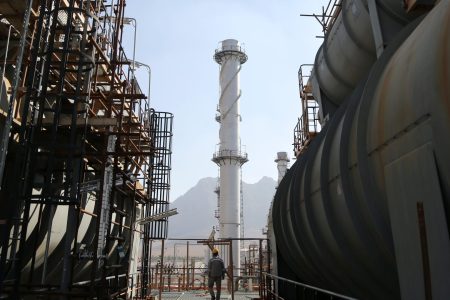A general view of Isfahan Refinery, one of the largest refineries in Iran and is considered as the first refinery in the country in terms of diversity of petroleum products in Isfahan, Iran on November 08, 2023.
Fatemeh Bahrami | Anadolu | Getty Images
Oil prices have jumped more than $5 a barrel since the start of the week amid intensifying fears that Israel could launch an attack on Iran’s energy infrastructure.
The rally, which puts crude futures on track for gains of around 8% week-to-date, has surprised many market observers in that it appears to be somewhat subdued given what’s at stake.
Energy analysts have questioned whether oil markets are being too complacent about the risk of a widening conflict in the Middle East, particularly given that the fallout could disrupt oil flows from the key exporting region. Iran, which is a member of OPEC, is a major player in the global oil market. It’s estimated that as much as 4% of global supply could be at risk if Israel targets Iran’s oil facilities.
Goldman Sachs says a sustained fall in Iranian output could send oil prices up $20 a barrel, while Swedish bank SEB has warned that crude futures could rally to more than $200 a barrel in an extreme scenario.
For some analysts, the reason crude prices have yet to move even higher is because the oil market is short. This refers to a trading strategy in which an investor hopes to profit if the market value of an asset declines.
“There is a very large short position, not only in oil, you [also] see it in equities. In general, the investors don’t like this space. Why? They are concerned about a big oil supply glut next year,” Jeff Currie, chief strategy officer of energy pathways at Carlyle, told CNBC’s “Squawk Box Europe” on Wednesday.

“When we look at the situation today, it is starkly different. Inventories are low, curve is backwardated, demand is middling, it’s not great but now you have [China’s] stimulus package on top of that, and you still have the OPEC production cuts,” Currie said.
“On top of that, we’ve thrown in potential conflict in the Middle East that could take out some energy facilities, so the near-term outlook is positive, which is why the front of the curve is strong, but it is being weighed down on the back end over the fears of this big oil supply glut,” he added.
The market is backwardated, or in backwardation, when the futures price of oil is below the spot price. The opposite structure is known as contango.
‘The market is so short’
Amrita Sen, founder and director of research at Energy Aspects, echoed Currie’s view.
“The market is so short. We’ve never seen these levels of record shorts before,” Sen told CNBC’s “Squawk Box Europe” on Thursday.
Many oil traders appear to have taken a bearish position on the belief that China’s stimulus rally will fail to restore confidence in the world’s second-largest economy, Sen said, adding that market participants also tend to expect OPEC and non-OPEC allies to boost oil production later in the year.

